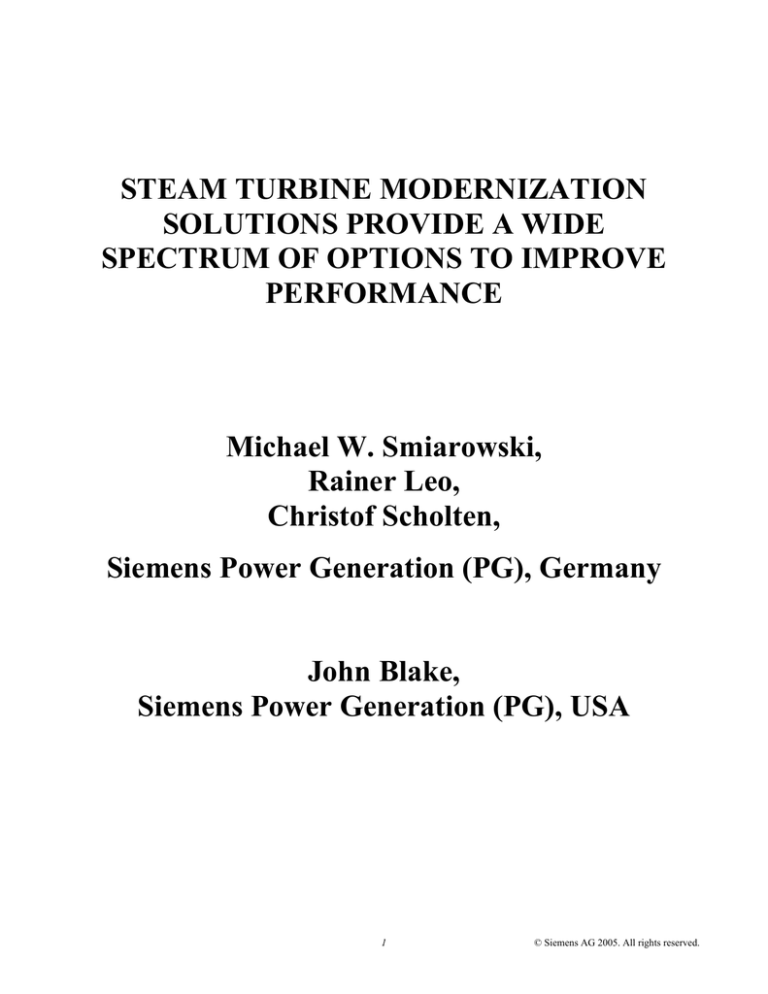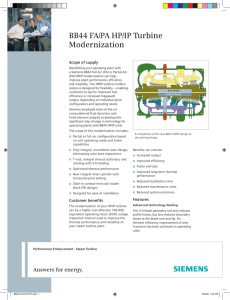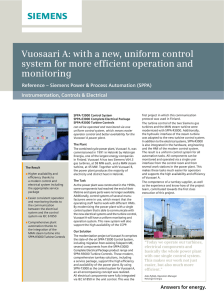
STEAM TURBINE MODERNIZATION
SOLUTIONS PROVIDE A WIDE
SPECTRUM OF OPTIONS TO IMPROVE
PERFORMANCE
Michael W. Smiarowski,
Rainer Leo,
Christof Scholten,
Siemens Power Generation (PG), Germany
John Blake,
Siemens Power Generation (PG), USA
1
© Siemens AG 2005. All rights reserved.
INTRODUCTION
Steam turbine modernization solutions are typically defined by their ability to increase electrical
output performance and/or heat rate reduction by application of the latest technologies. Siemens
Power Generation is continually involved in research and development to provide the most
advanced technologies for electricity producers in order to maximize the output of their turbine
generators.
Modernization solutions are normally considered for older turbines which utilize technology that
is approximately 30-years old or more, however recently, much newer steam turbine operators,
on units that are in operation for as little as 5-years, are inquiring into options to maximize their
performance output.
The turbine technologies that are available for existing units, as well as replacement steam paths,
are:
•
Advanced Shaft Sealing - retrofitting with retractable, brush, and abradable sealing
•
Blade Replacement - re-blading existing turbine stages with advanced blading, such as
3-dimensional blading
•
Major Component Modernization Options - entire replacement steam paths utilizing
state-of-the-art materials and technology to maximize performance and reduce
reliability and availability issues
•
Condenser Optimizations – analysis, reconfiguring, and tube replacement to optimize
the condenser performance
The key aspects of these technologies will be discussed to provide an executive summary of their
features and benefits.
2
© Siemens AG 2005. All rights reserved.
ADVANCED SHAFT SEALING TECHNOLGY
Improvements to the shaft steam sealing can be applied to existing operating units as well as new
steam paths. These technologies allow operation at smaller seal clearances and include features
that improve reliability in the event of rotor to seal contact.
These seal technologies are the abradable coating, retractable, and brush seals, which are
discussed below.
Abradable Coating Seals
In this solution, an abradable coating, normally of a metal alloy composition for steam turbines,
is applied by spray coating to the standard design seal segments. This reduces leakage flow by
reducing the tip clearances. As shown in figure 1, the abradable coating reduces the clearance
between the hard metal parts of the rotor and seal segment base material. The abradable coating
can be applied to various types of seal segments, especially for applications in the balance piston
and dummy piston section of high pressure turbines.
Figure 1 below shows the typical configuration for a Abradable Seal.
Abradable
Coating
Reduced
Clearance
Hard Part
Clearance
FIGURE 1- TYPICAL ABRADABLE SEAL ARRANGEMENT
3
© Siemens AG 2005. All rights reserved.
Operational benefits in the event of a rub, are that the sharp edge of the rotor seals, which are
harder that the abradable coating material, will have minimal damage or wear during contact
with the coating. Figure 2 below demonstrates this benefit between a hard rub (metal to metal
compared to a rub with coating.
Hard Rub
Rub with Coating
FIGURE 2- NORMAL SEAL (HARD RUB) AND ABRADABLE SEAL RUBBING COMPARISON
Based on scope of implementation, these generally provide 0.1 to 0.2% performance
improvement depending on application.
Retractable Seals
Conventional labyrinth seals are segmented and positioned by radial flat springs. Retractable
packing replaces the flat springs with coil springs between the segments to enlarge shaft
clearances during start-up in order to avoid damage caused by thermal distortion and vibration as
the unit passes through its critical speed zone. As shown in the figure 3 below, the coil spring at
the end of each seal segment holds the segment away from the shaft during start-up. At steady
state condition, high pressure steam enters the ring segments to restore design clearance for
normal operation at the design clearances.1
The retractable seal provides reliability improvements by making starts smoother and eliminating
contact during start-up. Fewer rubs translates into less maintenance on the seals. The smaller
clearances improves performance, sustains heat-rate, and reduces degradation.
1
Inventions and Innovations Impact Sheet – www.oit.doe.gov/inventions/folio/htmls/power/turbicare.shtml, p.1.
4
© Siemens AG 2005. All rights reserved.
FIGURE 3 – RETRACTABLE SEAL SEGMENT AND COIL SPRING
Brush Seals
An additional sealing technology is the use of brush tip seals that provide “zero clearance”
during operation and gives way during transients. The brush seals can be incorporated into the
retractable sealing design to give a very effective seal compared to previous designs and is
shown in figure 4
Sealing – Brush
Design Features
• Bristle pack allows very
tight clearances
• Reduced leakage flow,
approximately 50-70%
reduction compared to
standard labyrinth
• Bristles give way in
transient operation
Bristle
Pack
Flow
Reduced
Clearance
Backing
Plate
2-Stage Brush
Segment
Bristle angle
Customer Benefits
• Increase output and
efficiency
• No impact on operational
safety
Rotor
below.
December 17, 2004
Power Generation O21
4
FIGURE 4 – BRUSH SEAL ARRANGEMENT AND DETAIL
5
© Siemens AG 2005. All rights reserved.
BLADE REPLACEMENT WITH ADVANCED 3-DIMENSIONAL BLADING
With the continued advances in blading development, options exist where existing operating turbine
components, such as high pressure and intermediate pressure turbine sections can be upgraded by
replacing select blade rows with advanced blading. Siemens latest design blade family are the 3DV
and 3DS types. For example, as figure 5 shows below, Siemens Advanced 3DS airfoil design is
approximately 2% better on stage to stage efficiency than the former T4 blade profile design that it
replaced in the late 1990s.
FIGURE 5 – GRAPH COMPARING 3DS BLADING EFFICIENCY WITH FORMER T4 SERIES
The main technological improvements of these blades are:
• Fully 3D airfoil design
• Twisted blades – to reduce incidence losses
• 3DS
TM
blades – 3D design to reduce secondary losses
6
© Siemens AG 2005. All rights reserved.
Often times, utilities find that it is not feasible, due to time constraints, to remove a turbine
component, such as a High Pressure section, from service and replace blading and sealing. In
this situation, a “seed component” would be manufactured ahead of a planned maintenance
outage requiring 18 to 24 months lead-time. This new component would be available for a
future installation, which would minimize the outage duration. Such major component
replacements are discussed further below.
MAJOR TURBINE COMPONENT MODERNIZATION OPTIONS
This option involves replacement of the entire component, with reuse of the outer casings with
new components that use the latest technology. This approach corrects reliability issues and
improves performance, maintenance requirements, and emissions to levels comparable with new
turbines. This approach aims to reuse as much existing equipment as possible, such as bearings,
bearing pedestals, outer casings, piping, and supports. The modernized turbine steam path
incorporates much of the technology previously discussed such as new sealing, blading, and
larger cross sections to maximize performance.
EXAMPLE – HP/IP TURBINE MODERNIZATION (FOSSIL APPLICATION)
One example of a fossil steam path modernization is the BB44/044 replacement module which is
designed as a “drop in” replacement for the HP/IP (combined high and intermediate pressure)
turbine used in fossil power plants in 330 to 585 MW nominal application range that were
originally installed up to the mid-1980s. As figure 6 shows below, the original configuration is
shown on the lower-half of the split view. The modernized design appears in the upper-half
view. The main design and latest technology features in this new design are:
•
integral inner casing – reducing number of components
•
partial-arc admission or full arc design are both available
•
optimized blading
•
improved blade path seals
•
retractable HP and LP dummy seals
•
monoblock, no-bore rotor
7
© Siemens AG 2005. All rights reserved.
These features provide the following operational and maintenance benefits:
Triple Pin
Control
Stage
•
improved start-up times
•
simple installation
•
capable of daily start and stop operation
•
reduced alignment needs
Separately
Supported Nozzle
New, Integral
Inner Cylinder
Advanced 3D
Blade
Technology
Advanced
3D Blade
Technology
Monoblock
Rotor
FIGURE 6 – BB44/044 PARTIAL ARC CROSS SECTION AND COMPARISON WITH ORIGINAL
DESIGN (LOWER)
8
© Siemens AG 2005. All rights reserved.
EXAMPLE – LP TURBINE REPLACEMENT (FOSSIL APPLICATION)
The low pressure turbine modernization option is another long-term solution that addresses
reliability and maintenance problems of old components while providing the added benefit of
significant electrical performance increase. On certain low pressure turbine elements, stress
corrosion cracking (SCC) problems have been discovered in areas of the blade attachments or
blade roots in the wet regions of the steam path. Additional reliability problems in the blades
and tenons have been found that required repair or replacement.
Based on the remaining life time and other technical and economical factors, repairs like weld
repair and blade replacement may be a sufficient solution for units that have an imminent
retirement date. Once problems escalate and repair costs increase, then a modernization solution
may be the most technically and economical option. The photograph below in figure 7 shows a
typical LP turbine installation where the new LP turbine blade ring components are assembled
awaiting upper-half casing installation.
FIGURE 7 –LOW PRESSURE TURBINE REPLACEMENT FOR FOSSIL PLANTS
9
© Siemens AG 2005. All rights reserved.
EXAMPLE- STEAM PATH REPLACEMENTS (HP and LP) AT A NUCLEAR POWER
PLANT
A further example of a common modernization approach is the full steam path HP and LP
turbine replacement that a number of nuclear plants have implement within the last 10 years. On
the HP element, the standard approach is to replace the entire steam path – rotor and steam path
and reuse the outer casing. An example of this concept is shown in figure 8 below.
FIGURE 8 – NUCLEAR HIGH PRESSURE TURBINE REPLACEMENT
The nuclear HP turbine modernization is typically not reliability driven, but has been either due
to a thermal uprating program requiring more flow passing capability in the HP turbine or part of
a full steam path replacement project including LP turbines, or is due to the additional MW
gained by replacing the HP module.
Many LP turbines at nuclear plants have been replaced due to stress corrosion cracking concerns,
which has been found on all types of LP designs such as built-up disc, welded, and monoblock
rotors.
Siemens has provided its Advanced Disc Design LP rotors as a modernization
replacement for all mentioned designs for OEM and non-OEM applications and this is the
standard product offering for large nuclear LP rotor modernizations due to its trouble-free history
regarding SCC.
10
© Siemens AG 2005. All rights reserved.
The application uses a three disc per flow design and addresses the reliability issues of the old
turbines, while providing between 3-5 % performance improvement from technology alone.
MAIN LP TURBINE DESIGN FEATURES FOR NUCLEAR APPLICATIONS
The major design features that were incorporated into this LP turbine design are summarized
as follows:
•
Disc-type-rotors (shrunk on disc rotors) with optimized number of discs (three per
flow).
•
Integrally shrouded stationary and rotating drum stages with advanced 3D
blading. In addition, interstage sealing is accomplished through the “see-thru” or
parallel seal strip arrangement.
•
Free standing LP rotating section blades (3 stages per flow) with longer last stage
blades providing an increased exhaust annulus area.
•
Flame hardened leading edges of the LP freestanding rotating blades to mitigate
moisture erosion.
•
Forward leaning last stage stationary blades for improved last stage rotating stage
flow distribution.
•
Hollow vanes with moisture removal slots in the last stage stationary blade ring to
reduce moisture erosion.
•
High Chrome steel in erosion susceptible areas, e.g. high chrome steel blade
carriers and blade ring components.
Features that contributed to the increased performance improvement are:
• Able to use longer back-end blading
• Improved design of the last stage blades
• Improvement of cylindrical drum blades and twisted 3-dimensionally shaped drum blades
• Flexibility to optimize number of blade stages
• Improved blade sealing
• Optimized turbine design for the current steam conditions or optimized for a future uprate
11
© Siemens AG 2005. All rights reserved.
The main points of a HP and LP nuclear turbine modernization that contribute to the reliability
and extended maintenance intervals are:
1. Entire steam path is replaced which minimizes/eliminates the need for repairs of aging
equipment in the future and reduce the probability of a forced outage.
2. Major turbine components are ready for 40+ years service life that fits into license
extension plans.
3. Design is for 100,000 equivalent operating hour (EOH) inspection intervals.
FIGURE 9 – TYPICAL ADVANCED DISC DESIGN LOW PRESSURE TURBINE MODERNIZATION
CROSS SECTION
12
© Siemens AG 2005. All rights reserved.
CONDENSER REPLACEMENT AND OPTIMIZATIONS
Another option that can be implemented to improve performance of steam turbines is a
condenser optimization. This can be a stand-alone project or can be performed in conjunction
with other turbine modernization options. This option entails first performing a conditional
survey on the existing condenser to determine potential improvements. Modifications can range
from reconfiguring the existing condenser tubes for better flow and reduced backpressure up to a
new condenser replacement.
The benefits of the condenser optimization can include:
•
Lower Back Pressure - Higher Power Output
•
Increased Condensate Deaeration
•
Lower Condensate Subcooling
•
Possibility of higher output LP modernization
Additionally, new materials, such as titanium and stainless steel, are used on replacement tube
bundles, which provides maintenance, reliability, and availability benefits such as:
•
Reduced Condenser Tube Corrosion and Erosion
•
Improved Cleanliness Factor
•
Reduced Cooling Water in-leakages or “Tight Condenser“
•
Minimized Stress Corrosion in Steam/Water Cycle
13
© Siemens AG 2005. All rights reserved.
CONCLUSION
Modernization solutions are the application of the latest steam turbine technology to existing
machines to maximize their efficiency, improve reliability, and reduce life cycle costs. The
discussion of these solutions focused on the technology and application of these options, which
can range from replacing seals with upgraded designs at a scheduled maintenance outage, up
through major component replacement and the alternatives in between. All options provide a
definite payback period that in most cases “pays for itself” in under 5-years. In many cases,
these can be considered investments rather than expenses associated with traditional maintenance
work.
The main characteristics and benefits of modernization projects are that they provide:
•
Reduced Maintenance Costs
•
Increased Capacity and Associated Revenues
•
Improved Efficiency and Lower Fuel Consumption
•
Improved Availability and Reliability
•
Reduced Emissions
With the demand for electricity on the increase, plant operators are continually looking for ways
to improve the efficiency and operation of their existing steam turbines. The modernization
solutions discussed provide cost effective solutions while being environmentally friendly and
reliable.
14
© Siemens AG 2005. All rights reserved.



